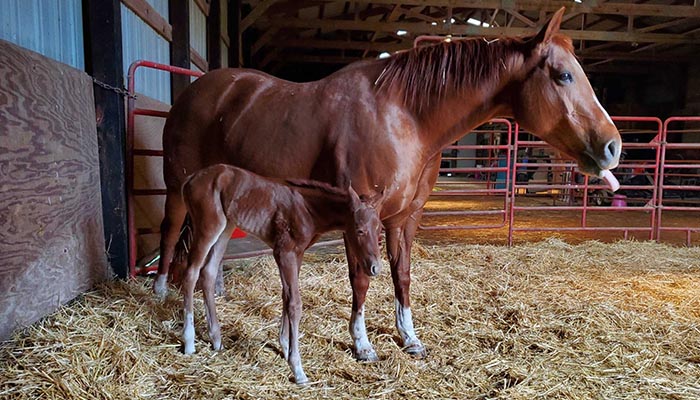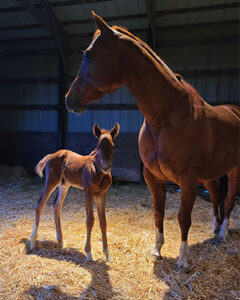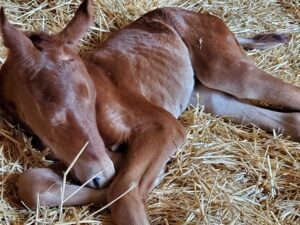
After 11 months of waiting, our new bundle of joy finally made an appearance on May 5, 2023. During the approaching weeks, my mother and I had spent a great amount of time preparing the stall and monitoring my mare Sky for the arrival of our new addition. You can read more about breeding Sky and her pregnancy journey in my previous Breeding Chronicles blog posts.
Because Sky was due at the end of April, we started pH testing her mammary secretions in early May. Testing the pH levels does not influence the mare’s supply, but it can help to estimate when your mare will foal. Generally, the mammary secretions will measure above 6.4 during pregnancy, but once the mare begins to produce colostrum, the pH level of the secretions will drop. Once the mare begins to produce colostrum, it is a good indicator that the mare will foal within the next 72 hours.
My mom had been doing the pH test strips on Sky’s secretions for several days, and on the morning of Friday, May 5, the pH dropped dramatically. We were all so excited for the foal at this point! Later in the afternoon, her teats began to drip secretions/colostrum, and her teats “waxed” up. According to Dr. Dave Hanlon, BSc BVMS (Hons) MACVSc MVSc DiplACT, “Waxing is the appearance of beads of wax-like material on the ends of the teats. This wax is actually colostrum which oozes from the teats in the last few days of pregnancy. Waxing occurs in about 95% of mares 6 to 48 hours before foaling; however, it can also occur several days before foaling or sometimes not at all.”
Fun fact: many studies have shown that the vast majority of mares foal at night (86%, according to Dr. Hanlon!). This is most likely due to the evolution of the species and wanting to ensure that foals were born under cover of darkness.
Because Sky’s pH had dropped and she was waxed up, my mother decided to spend the night in the barn. My husband, David, hoped to see the birth, so I sent him to the barn while I stayed home with our kids. I assumed the foal would be born early in the morning or perhaps the next night; after all, Sky was a maiden mare—but I was wrong!

A gorgeous chestnut colt with white socks and a teeny weeny snip was born at 9:30 pm that night. The birth went quickly and smoothly and was not eventful, which is a good thing! David called to tell me the baby had arrived; I thought he was joking! We did not anticipate him coming so quickly that evening, so it was a very welcome surprise—we were prepared for multiple nights of foal watch. I packed the kiddos and headed to the barn to meet our newest addition.
The foal was on his feet within an hour, giving us more time to fawn over him and Sky. The colt has tiny freckles on his socks, making him extra special. We did have a giggle because we were hoping for a paint color pattern, and this baby was a solid chestnut. However, that certainly isn’t a problem! We bred to his sire, Dual Reyish, for his athletic prowess and success in the show ring. Hopefully, this colt follows in his footsteps (er, hoof steps!).
After the birth, my mother checked the placenta carefully. It is vital to ensure that the whole placenta has been expelled from the mare’s uterus, because if any bits of the placenta remain, it can cause an infection down the road. The placenta was intact, making it a very successful and straightforward birth. We were all so excited that everything had gone to plan.
Unfortunately, Sky was not as excited as we were. She was very wary of the colt and did not want to let him nurse. She kept looking at him, twisting her head, and threatening to bite the poor little guy. We tried to hold her to allow the foal to nurse, but she was intent on not letting him near her. This can be a scary situation, but it’s not all that uncommon with maiden mares unfamiliar with foals.
We called our veterinarian, Dr. Sawyer Shattuck, of Shattuck Veterinary Services, to see what he would suggest. We tried unsuccessfully to use food to distract Sky and allow the colt to nurse. Dr. Shattuck told us that the best course of action would be to sedate Sky so the foal could nurse and access the colostrum.
The colostrum is the milk that the mare produces for the first 12-24 hours after birth. In addition to being more concentrated in protein, fat, vitamins and minerals, and sugars than milk, it contains the necessary immunoglobulins (antibodies) to protect the foal from infectious diseases during the first months of their life.
After giving Sky a mild sedative, she relaxed and allowed the foal to nurse. Dr. Shattuck explained that some maiden mares will accept the foal after they have settled from the birth experience. Fortunately, this was true of Sky. She continued to allow the foal to nurse as the sedation wore off and has been an excellent mother ever since, adjusting well to her foal nursing.
Dr. Shattuck returned a few days later to recheck the foal and Sky. He did an antibody test to ensure that the colt got enough colostrum into his system and would not need medical attention; fortunately, everything looked great!
Although we had some excitement in the hours following the birth, everything has gone smoothly since then. Sky has shown great affection for her colt, whom we named Sherman, and is helping him explore his surroundings safely.

Going forward, I plan to ride Sky and get her back into shape with the foal by her side. We have already gone on a few rides together in the pasture, and it is so special and so much fun to have her colt bouncing along beside us. I plan to get Sky and myself both back into some competitions after she is weaned from her foal this fall.
I am so proud of Sky and her gorgeous colt. I am looking forward to our future together!
Read all about Maria’s adventures breeding her mare on our Breeding Chronicles Blogs, including Breeding Chronicles Part I: Considerations When Deciding to Breed My Mare, Breeding Chronicles Part II: Selecting a Stallion, Breeding Chronicles Part III: The Process of Breeding My Mare, Breeding Chronicles IV: Prenatal Mare Care, and Breeding Chronicles V: Nominating the Foal for Incentive and Futurity Programs.
